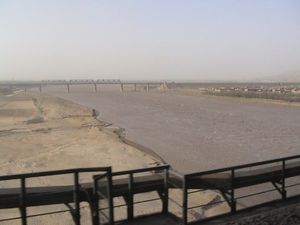Yellow journalism
HOLY SHIT. HAVE YOU HEARD ABOUT YELLOW JOURNALISM? NO? WELL IT’S ONLY THE BEST WAY TO GET INFORMATION ABOUT THE WORLD AROUND YOU! IT’S ABSOLUTELY NOT EXAGGERATED AND ALWAYS CORRECT IN ITS INTERPRETATION OF CURRENT AFFAIRS AND HISTORY! ONLY THE LIVELIEST IN AMERICAN SPIRIT AND MOST FASHIONABLE IN INTELLECTUALISM CAN COMPREHEND AND UNDERSTAND THE MAGNIFICENCE OF THE WRITTEN WORKS OF THIS SUPERIOR FORM OF GATHERING AND SPREADING INFORMATION!
Origin[edit | edit source]
Yellow journalism was established in China during the early Chang Dynasty to document and update the people on the activity of the Yellow River. Those tasked with yellow journalism were usually the low-lives of the village, and were enough of a threat to overall productivity that the emperor felt the need to distance them from the rest of the population by assigning them menial labor. Because the Yellow River generally did not do anything wacky or interesting on most days, the journalists would often exaggerate the day’s happenings in their reports, hence the origin of yellow journalism’s current connotations.
After hundreds of years, white people arrived, got all the locals high on opium, and used this newfound opportunity to appropriate the shit out of yellow journalism while everyone else was busy getting high until it became the bastard child we know and love today. Eventually, they also appropriated the Yellow River itself, and it quickly became so full of garbage and lighter fluid that it won the title of “Most Flammable River in the World” in 1983.
The Golden Age[edit | edit source]
Yellow Journalism reached its peak in the late 1800s, back when everyone in America was stupid. It was used because people in urban areas were getting bored of chucking their waste out of their own windows onto the streets below, and rural folk had nothing left to attend to after slavery was abolished. Yellow journalism provided a means of entertainment while also tricking readers into believing that they were really learning about the world.
Fuck Spain[edit | edit source]
Back in the days of yellow journalism, America had an egregious amount of beef with Spain. Therefore, yellow journalism was used to rile the people up and eventually kick the Spaniards out of Cuba. In hindsight, this ended up being a bad idea for multiple reasons:
- Cuba later became communist, an ideology with which America ended up having even more beef with
- America had also acquired Florida from the Spanish years earlier. This should’ve been an obvious sign that taking Spain’s things was generally a bad idea.
Current Day[edit | edit source]
After the Spanish pissed off, yellow journalism seemed to lose its purpose. Former yellow journalists began to lose readers because everyone who could read was being drafted. A small resurgence of yellow journalism happened during the presidency of Richard Nixon, but it ceased when the journalists managed to achieve their goal of getting Nixon to leave office. They decided to quit while they were ahead.
In the 21st Century, China reclaimed yellow journalism and it has returned in the form of the Chinese News Agency.
How to Spot Yellow Journalism[edit | edit source]
The idea behind being a yellow journalist is that nobody’s supposed to know that one’s a yellow journalist. Otherwise, their cover is blown and they may be subject to punishment by your employer. So if you at all value human life, it’s recommended to not look for and call out yellow journalism at all. If necessary, however, here’s some great tips to spot an article written by a yellow journalist:
- If the article itself is yellow, chances are you’re reading yellow journalism. It may not be the kind we’re going over, but its important to identify regardless.
- If the article is exaggerated to the point of not being depressing, it’s definitely yellow journalism. There is no such thing as happy news, only bad news. They say “no news is good news,” but if there was no news, it would surely be a newsworthy occasion, and therefore would be bad news.
 | This article needs to be grown |

